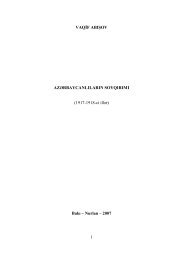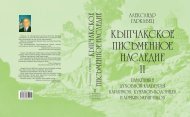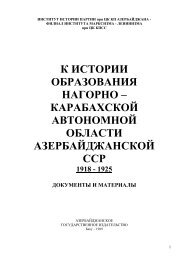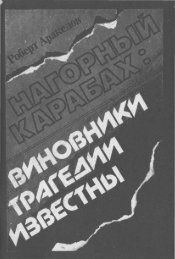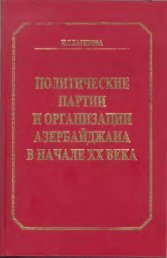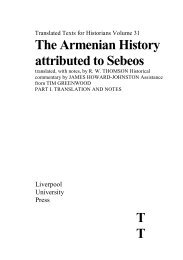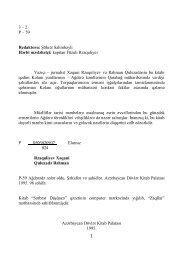ARMENIAN - Erevangala500
ARMENIAN - Erevangala500
ARMENIAN - Erevangala500
You also want an ePaper? Increase the reach of your titles
YUMPU automatically turns print PDFs into web optimized ePapers that Google loves.
Beylerbey Palace on the Bosphorus, one of the masterpieces<br />
of the Ottoman-Armenian architect, Agop Bey<br />
Balyan, was the scene of a meeting between Sultan<br />
Abdul Hamid and Russian Grand Duke Nicholas. At the<br />
beginning o f the war, the Armenians had solemnly<br />
declared their loyalty to the Ottoman Empire, but in the<br />
Ottomans' hour of greatest need, the Armenians, who had<br />
always been the "loyal millet" in the past, ran to the<br />
Russians and tried to take advantage of the situation. The<br />
Ottomans could never forget this breach o f faith.<br />
Ottoman-Armenian relations started becoming more difficult<br />
from that moment on.<br />
sians, who sometimes found the Armenian minority<br />
useful for their territorial expansion in the East.<br />
Occasionally, they even used the Armenians as<br />
henchmen to spread fear and panic among the Moslems<br />
without getting their own hands dirty. (A good<br />
example is the conquest of Erzurum in 1839 where<br />
the Armenians were responsible for a massacre of<br />
Moslems.)<br />
1877 With the Balkans already given away, it became<br />
clearer and clearer that the Russians wanted to advance<br />
along the Erzurum-Alexandretta (today<br />
Isken-derun) axis toward the Mediterranean. Now<br />
the Armenians started to take on real importance for<br />
the Russians. They were expected to serve as a Fifth<br />
Column. At this point, the Russians no longer<br />
restricted themselves to exploiting the Armenian<br />
clergy. They started using the Armenian revolutionary<br />
cadres more and more. At the same time,<br />
the English developed an interest in the Armenians.<br />
They came up with the idea of an Armenian buffer<br />
state, which could serve as a check on the great<br />
powers in the event of a collapse o f the Ottoman<br />
Empire.<br />
1877 April 24 saw the beginning of a new war with<br />
Russia. It was the shortest of all the wars, but also<br />
the most devastating for the Ottomans. "The catastrophe<br />
of twelve-ninety-three" (that was the year<br />
according to the Ottoman calendar) is still proverbial<br />
for the Turks o f today. From the start, the<br />
Russians had the advantage on the eastern front.<br />
Kars fell on November 18. The Russians were under<br />
the command o f the Armenian general Loris<br />
Melikof. While Erzurum stood firm against all the<br />
Russian attacks, the Turks suffered a disastrous<br />
defeat near Plevne on the Balkan front.<br />
1878 The Armistice of Edime was concluded on January<br />
31. The fate of the Ottoman Empire appeared to be<br />
sealed. Nothing could stop the Russians from<br />
marching right on to Constantinople.<br />
The Armenians now established contact with the<br />
Russians in Edime. At the beginning o f the war,<br />
they had stood solidly behind their Ottoman fatherland.<br />
Now, after the catastrophe o f Plevne, the entire<br />
Armenian camp swung over to the Russian side.<br />
The first contacts took place in Edime. Whether and<br />
in what way the patriarch and the catholicos were<br />
involved in this scenario is a subject of debate. In<br />
any case, the result of these interventions was that<br />
the Russians interceded expressly on behalf of the<br />
Armenians in the peace dictate of San Stefano. The<br />
wording of the passage was, however, left entirely<br />
non-commital since the Russians clearly had no intention<br />
of granting independence to their own<br />
Armenians.<br />
Article 16 of the Treaty o f San Stefano (Yesilkoy)<br />
states: "... la Sublime Porte s'engage a realiser sans<br />
plus de retard les amelioration et les reformes<br />
exigees par les besoins locaux dans les provinces<br />
habitees par les Armeniens et a garantir leur securite<br />
contre les Kurdes et les Circassiens."<br />
This totally empty clause does nothing more than<br />
demand that the Ottomans provide for the security<br />
of the Armenians against Kurdish and Circassian attacks.<br />
It was nevertheless a turning point. The Armenians<br />
had now for the first time been mentioned<br />
in an international treaty, even if it was in fact a dictate.<br />
The Armenians appreciated it, regardless o f its<br />
insignificance (and the Russians had good reason<br />
for making it so insignificant).<br />
Only too soon did it become clear that the "peace<br />
treaty" of San Stefano was o f a very provisional nature.<br />
Both England and Austria rejected it. Eventually<br />
the parties agreed to Bismarck's suggestion<br />
that a conference be held in Berlin to deal with the<br />
Ottoman Question.<br />
The representatives of the great powers met in Berlin<br />
from June 13 to July 13, 1878. Aside from the<br />
two chancellors, Gorchakov and Bismarck, those<br />
present in the new German capital included Count<br />
An-drassy of Austria-Hungary, Lord Beaconsfield of<br />
Great Britain, Waddington of France, Corti of Italy,<br />
51



